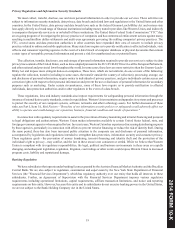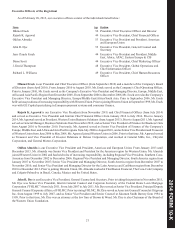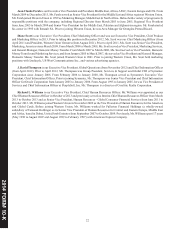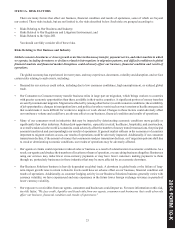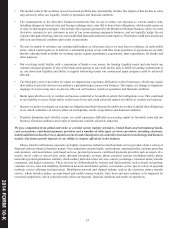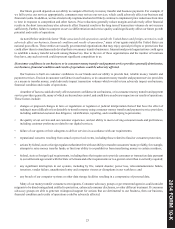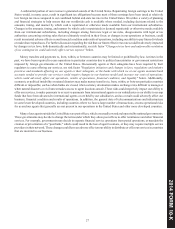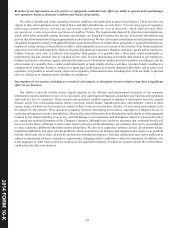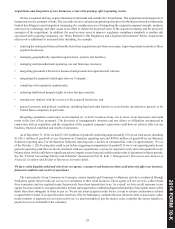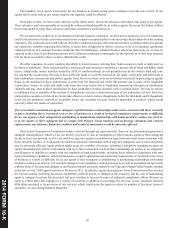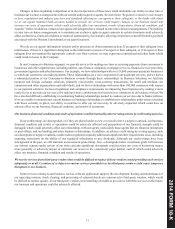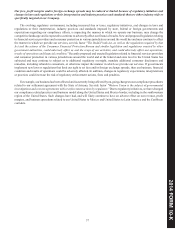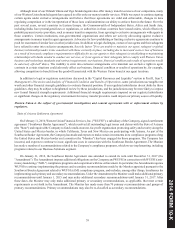Western Union 2014 Annual Report Download - page 167
Download and view the complete annual report
Please find page 167 of the 2014 Western Union annual report below. You can navigate through the pages in the report by either clicking on the pages listed below, or by using the keyword search tool below to find specific information within the annual report.
2014 FORM 10-K
29
Acquisitions and integration of new businesses create risks and may affect operating results.
We have acquired and may acquire businesses both inside and outside the United States. The acquisition and integration of
businesses involve a number of risks. The core risks involve valuation (negotiating a fair price for the business based on inherently
limited due diligence) and integration (managing the complex process of integrating the acquired company's people, products
and services, technology and other assets in an effort to realize the projected value of the acquired company and the projected
synergies of the acquisition). In addition, the need in some cases to improve regulatory compliance standards is another risk
associated with acquiring companies, see "Risks Related to Our Regulatory and Litigation Environment" below. Acquisitions
often involve additional or increased risks including, for example:
• realizing the anticipated financial benefits from these acquisitions and where necessary, improving internal controls of these
acquired businesses;
• managing geographically separated organizations, systems and facilities;
• managing multi-jurisdictional operating, tax and financing structures;
• integrating personnel with diverse business backgrounds and organizational cultures;
• integrating the acquired technologies into our Company;
• complying with regulatory requirements;
• enforcing intellectual property rights in some foreign countries;
• entering new markets with the services of the acquired businesses; and
• general economic and political conditions, including legal and other barriers to cross-border investment in general, or by
United States companies in particular.
Integrating operations could cause an interruption of, or divert resources from, one or more of our businesses and could
result in the loss of key personnel. The diversion of management's attention and any delays or difficulties encountered in
connection with an acquisition and the integration of the acquired company's operations could have an adverse effect on our
business, financial condition and results of operations.
As of December 31, 2014, we had $3,169.2 million of goodwill comprising approximately 32% of our total assets, including
$1,950.1 million of goodwill in our Consumer-to-Consumer reporting unit and $996.0 million of goodwill in our Business
Solutions reporting unit. For the Business Solutions reporting unit, a decline in estimated fair value of approximately 15% as
of the October 1, 2014 testing date could occur before triggering an impairment of goodwill. If we or our reporting units do not
generate operating cash flows at levels consistent with our expectations, we may be required to write down the goodwill on our
balance sheet, which could have a significant adverse impact on our financial condition and results of operations in future periods.
See the "Critical Accounting Policies and Estimates" discussion in Part II, Item 7, Management's Discussion and Analysis of
Financial Condition and Results of Operation, for more detail.
We face credit, liquidity and fraud risks from our agents, consumers and businesses that could adversely affect our business,
financial condition and results of operations.
The vast majority of our Consumer-to-Consumer money transfer and Consumer-to-Business activity is conducted through
third-party agents that provide our services to consumers at their retail locations. These agents sell our services, collect funds
from consumers and are required to pay the proceeds from these transactions to us. As a result, we have credit exposure to our
agents. In some countries, our agent networks include superagents that establish subagent relationships; these agents must collect
funds from their subagents in order to pay us. We are not insured against credit losses, except in certain circumstances related
to agent theft or fraud. If an agent becomes insolvent, files for bankruptcy, commits fraud or otherwise fails to pay money order,
money transfer or payment services proceeds to us, we must nonetheless pay the money order, complete the money transfer or
payment services on behalf of the consumer.


